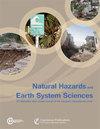Seismogenic potential and tsunami threat of the strike-slip Carboneras fault in the western Mediterranean from physics-based earthquake simulations
IF 4.7
2区 地球科学
Q1 GEOSCIENCES, MULTIDISCIPLINARY
引用次数: 3
Abstract
Abstract. Strike-slip fault ruptures have a limited capacity to generate vertical deformation, and for this reason they are usually dismissed as potential destructive tsunami sources. At the western tip of the western Mediterranean, in the Alboran Sea, tectonics is characterized by the presence of large transcurrent fault systems and minor reverse and normal faults in a zone of diffuse deformation. The strike-slip Carboneras fault is one of the largest sources in the Alboran Sea and therefore with the greatest seismogenic capacity. It is also one of the active structures with higher slip rates in the eastern Betic fault zone and has been proposed as the source of the damaging 1522 (M 6.5; Int. VIII–IX) Almeria earthquake. The dimensions and location of the Carboneras fault imply a high seismic and tsunami threat. In this paper we present tsunami simulations from seismic sources generated with physics-based earthquake simulators. We have generated a 1 Myr synthetic seismic catalogue consistent on 773 893 events, with magnitudes ranging between Mw 3.3 and 7.6. From these events we have selected those sources producing a potential energy capable of generating a noticeable tsunami, those sources being earthquakes with magnitudes ranging from 6.71 to 7.62. The Carboneras fault has the capacity to generate locally damaging tsunamis; however, on a regional scale its tsunami threat is limited. The frequency–magnitude distribution of the generated seismic catalogue reflects the variability of magnitudes associated with the rupture of the entire fault, departing the upper limit from the classical Gutenberg–Richter potential relation. The inter-event time for the maximum earthquake magnitudes is usually between 2000 and 6000 years. The use of physics-based earthquake simulations for tsunamigenic sources allows an in-depth characterization of the scenarios, allowing a qualitative leap in their parametrization.基于物理的地震模拟研究地中海西部走滑Carboneras断层的地震潜力和海啸威胁
摘要走滑断层破裂产生垂直变形的能力有限,因此,它们通常被视为潜在的破坏性海啸源。在地中海西部的西端,在阿尔博兰海,构造的特点是在扩散变形带中存在大型横贯断层系统和小型反向断层和正断层。走滑Carboneras断层是阿尔博兰海最大的震源之一,因此具有最大的发震能力。它也是东部贝蒂奇断层带中滑动率较高的活动结构之一,并被认为是1522年(M 6.5;Int.VIII–IX)阿尔梅里亚地震的震源。Carboneras断层的尺寸和位置意味着地震和海啸的高度威胁。在这篇论文中,我们介绍了基于物理的地震模拟器生成的震源海啸模拟。我们生成了一个1 与773一致的Myr合成地震目录 893次,震级在3.3至7.6级之间。从这些事件中,我们选择了能够产生明显海啸的势能来源,这些来源是震级在6.71至7.62级之间的地震。Carboneras断层有能力产生局部破坏性海啸;然而,在区域范围内,其海啸威胁是有限的。生成的地震目录的频率-震级分布反映了与整个断层破裂相关的震级变化,偏离了经典古腾堡-里希特电位关系的上限。最大地震震级的事件间时间通常在2000年至6000年之间。对海啸震源使用基于物理的地震模拟,可以深入描述场景,从而在参数化方面实现质的飞跃。
本文章由计算机程序翻译,如有差异,请以英文原文为准。
求助全文
约1分钟内获得全文
求助全文
来源期刊
CiteScore
7.60
自引率
6.50%
发文量
192
审稿时长
3.8 months
期刊介绍:
Natural Hazards and Earth System Sciences (NHESS) is an interdisciplinary and international journal dedicated to the public discussion and open-access publication of high-quality studies and original research on natural hazards and their consequences. Embracing a holistic Earth system science approach, NHESS serves a wide and diverse community of research scientists, practitioners, and decision makers concerned with detection of natural hazards, monitoring and modelling, vulnerability and risk assessment, and the design and implementation of mitigation and adaptation strategies, including economical, societal, and educational aspects.

 求助内容:
求助内容: 应助结果提醒方式:
应助结果提醒方式:


